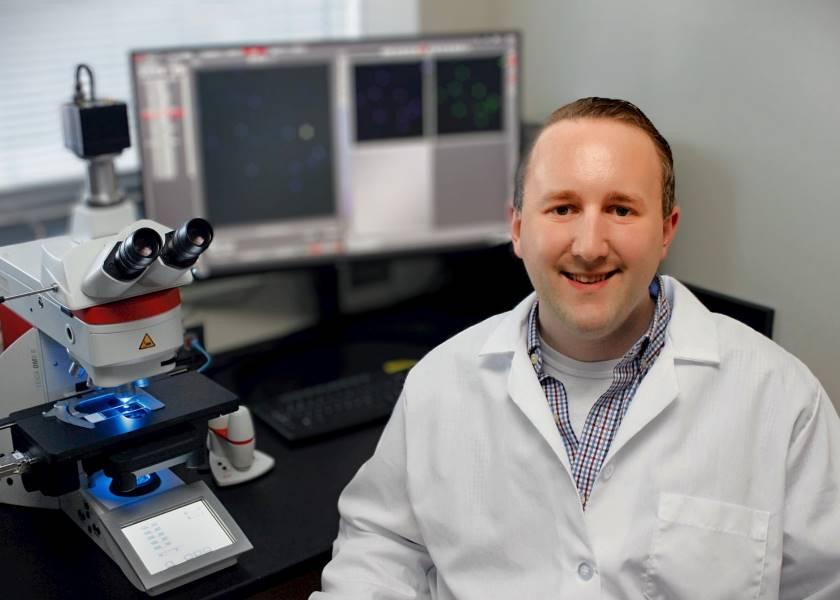How Does Iowa State Research on Swine Sire Fertility Impact Cattle, Humans?

Sire infertility is a problem for the reproductive performance of swine, despite the greater attention that has long been given to the female side of the equation.
“We know that 25% of the boar herd has less than 80% conception rates, which is considered unacceptable by industry,” said Karl Kerns, assistant professor of animal science at Iowa State University and 2014 alum of the same department. “By adding even one more pig to a litter, we could increase production by an estimated $120 million annually. To improve that, we need to learn more about what influences the capacity of sperm to fertilize. That means developing better tools for researching sperm health – and making it easier for the industry to use the knowledge we already have.”
Kerns is leading a new five-year grant from the USDA National Institute for Food and Agriculture to support research on boar sperm capacitation -- the biological pathways that support spermatozoa’s ability to fertilize. The grant is one of 14 funded nationwide under NIFA’s Agriculture and Food Research Initiative (AFRI) - Animal Reproduction Program. This project, and two other recent awards to collaborate with colleagues at the University of Missouri and the USDA Agricultural Research Service, total $1.7 million in federal support for Kerns’ work studying male fertility.
Kerns takes a molecular approach to analyze the biochemical makeup of sperm, especially the proteins, fats and energy sources that signal which sperm are more – or less -- fertile. The AFRI project focuses on swine, but has implications for other species, including cattle and humans.
To study sire fertility, he uses a state-of-the-art piece of equipment found in few andrology labs around the world: an image-based flow cytometer, “basically a high-throughput microscope,” he explained. In a matter of a 30-60 seconds, the cytometer allows imaging of up to 10,000 sperm cells and up to nine biomarkers within each cell. Kerns then uses computer-based artificial intelligence to link the resulting vast data set of images with reproductive outcomes. This kind of equipment and approach has become more common in human health research, such as the cancer field, but it has not been used to study livestock fertility, according to Kerns.
The project has multiple goals, including reducing barriers in the swine industry to use the best available information on swine genetics and reproductive capacity.
“In the past, the uptake of relevant technology has been slowed by the high cost of lab equipment, the need for highly skilled labor and increased analysis time, none of which are conducive to production,” said Kerns. “This new project will use analytical software resources aimed at providing accessible, economical methods and equipment that can more quickly translate findings from the lab bench to barns.”
Another aspect of the research is to investigate the lipid (or fats), protein and energy sources of fertile spermatozoa to see if supplements can increase sperm cell survival after insemination and boost fertility.
His previous foundational work has already had an impact on the livestock industry. While doing graduate and postdoctoral research at the University of Missouri, he and his team found a relationship between zinc ions and the fertilization competency of boar spermatozoa. That information, now termed the “mammalian sperm zinc signature,” has improved boar and bull fertility diagnostics. Further research on the influence of zinc on sperm health is an ongoing area of focus.
“Male fertility is one part of the fertility equation that is often overlooked, but it’s critically important,” Kerns said. “However, this is not just about swine. We are taking a ‘One Health’ approach that is likely to be relevant to other mammals, including cattle and humans. For instance, infertility is a costly issue for the beef industry, representing a $4.7 billion annual loss for U.S. cattle producers.”
“Eventually this could also lead to better fertility diagnostics for humans,” he said. “One out of eight couples struggle with infertility. We know that men contribute up to two-thirds of the problem directly and indirectly. Current human infertility treatments are not only very expensive, with low success rates, but also can put undue stress on the emotional health of the couple when not diagnosed correctly. Having better diagnostics to identify male fertility issues, and better ways to address them, could reduce the stigma we now often unduly place on women and greatly boost reproductive success for couples.”
Read more from Farm Journal's PORK:







